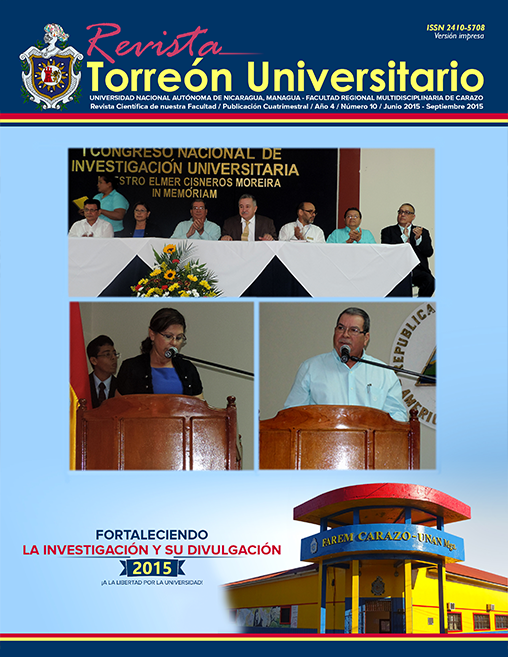Valuation of the Professors Technological Competencies of UNAN-MANAGUA, Case: FAREM-CARAZO
Abstract
In the current society, the technologies of information and communication, TIC, revolve around all the processes of information and communication, distinguishing the telematics and communicative processes. This is so, until the society of this century turns out to be called “the information society”, “Web generation”, “generation I”, (of internet and/or information), and including the WhatsApp generation. Also in words of professor Manuel Castell (2001): society in net, or, the information era; as Echaverrìa (2000) points out, the new technologies light a new social space; the third environment, which clearly differs from the natural and urban ones.
This study takes as one of its principles, the proposals already indicated by UNESCO related to the project “standards of TIC competencies for teachers”, ECD-TIC (as in Spanish), when noting that “teachers need to be prepared to empower students with the advantages given by TIC. Schools and classroom, face-to-face or virtual ones should count with teachers who have the competencies and resources of TIC and being able teach efficienly the correspondent subjects, including at the same time in their teaching, concepts and abilities of them” (UNESCO, 2008:p.6).
In this sense, we focus our context of doing on detecting the formative TIC needs that teachers have in FAREM-Carazo. So based on that, design and implement a virtual space for the didactic use of applications of the Web 2.0.
Downloads
References
Ausubel, D. (1976). Psicología Educativa. México: Trilla.
Barriga Arceo, F., & Hernández Rojas, G. (2010). Estrategias docentes para un aprendizaje significativo: Una interpretación contructivista. México, D.F: McGrawHill.
Briones, G. (2002). Metodologia de la Investigacion cuantitativa en las Ciencias Sociales. Bogotá: ARFO.
Castells, M. (2001.). La Cultura de la libertad como constitutiva de Internet. Conferencia inaugural del curso académico 2001-2002 de la UOC. Disponible en: http://www.uoc.edu/web/esp/launiversidad/inaugural01/intro_conc.html
Echeverria, J. (2000). Los Señores del aire: Telépolis y el Terecer Entorno. Barcelona: Destino.
Gálvez, A., & Tirado, F. (2006). Sociabilidad en Pantalla. Un estudio de la interacción en los entornos virtuales . Barcelona España: UOC.
Kuhn, T. (1962). Concepto de Paradigma. Disponible en: http://www.lapaginadelprofe.cl/metodo/introdmetodologia/introdmetodologia15.htm
López Meneses, E. y Vázquez Cano, E. (2013) WEB 2.0 Tools for social Educator training in Higher Education. International Journal of Research In Social Sciences, 3 (2); 1-13. Disponible en: http://ijsk.org/uploads/3/1/1/7/3117743/1_education_trainning_tool.pdf
UNESCO (2008) Estándares de Competencias TIC para Docentes. Disponible en: http://www.oei.es/tic/UNESCOEstandaresDocentes.pdf
Downloads
Published
How to Cite
Issue
Section
License
Copyright (c) 2016 Revista Torreón Universitario

This work is licensed under a Creative Commons Attribution-NonCommercial-NoDerivatives 4.0 International License.
The authors who publish in this journal agree to the following terms.
- The author or authors of the articles, essays or research grant the National Autonomous University of Nicaragua, Managua (UNAN-Managua) the editing rights (copyright) of the submitted work, therefore the University has the exclusive right to publish the article for the entire copyright period.
- These copyrights/authors authorize Torreón Universitario Magazine and the University to edit and disseminate/publish the article in said Magazine, including printed and electronic reproduction, storage, retrieval and any other type of publication, and sources of secondary information as services. of summaries and databases, they also empower it to protect the article against unauthorized use for dissemination by printed or electronic media (PDF, HTML, EPUB, XML or others).
License for use of content
The magazine uses the Creative Commons Attribution-NonCommercial-NoDerivs 4.0 International License.
Under this statement:

This journal is licensed under a Creative Commons Attribution-NonCommercial-NoDerivatives 4.0 International License. It can be copied, distributed and transmitted publicly as long as the author and source are cited (Revista Torreón Universitario), it should not be modified or used for any commercial purpose. The full license can be found at http://creativecommons.org/licenses/by-nc-nd/4.0/.



